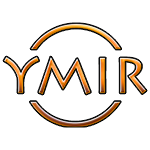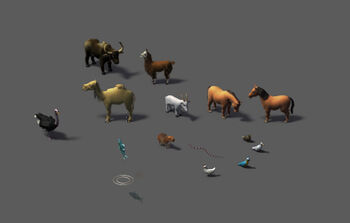Explodeysquirrel (talk | contribs) (Deers can't be raised in Nordic climates) |
Explodeysquirrel (talk | contribs) mNo edit summary |
||
| Line 35: | Line 35: | ||
(+50% Growth) |
(+50% Growth) |
||
| + | |||
| + | (-50% Cargo) |
||
! |
! |
||
! style="padding: 8px" |[[File:Green check.svg|center|32px|frameless]] |
! style="padding: 8px" |[[File:Green check.svg|center|32px|frameless]] |
||
| Line 151: | Line 153: | ||
! rowspan="4" |Military |
! rowspan="4" |Military |
||
| + | (-25% Growth) |
||
| − | Units |
||
! |
! |
||
! style="padding: 8px" |Wild Only |
! style="padding: 8px" |Wild Only |
||
Revision as of 05:37, 31 May 2019
Animals in Ymir are a source of meat and leather and can be found in four forms:
- As a Resource that can be gathered by a hunter.
- As a herd roaming on the world map, which the player can either hunt or capture.
- As a hostile Unit during a random event while exploring the world map.
- As an inventory item obtained through capture or breeding.
While a hunter or attacking a herd provides meat and leather directly, animals in inventory form must be processed by a butcher.
note: disbanding an army unit animal will turn it into its inventory form and the player will not be able to recruit it anymore.
Animals on the Worldmap
| Portrait | Animal Name | Primary
Industry |
Cold | Temperate | Hot | |||||
|---|---|---|---|---|---|---|---|---|---|---|
| Polar | Nordic | Oceanic | Continental | Mediterranean | Arid | Desert | Tropical | |||
| Rabbit | Meat Only
(+50% Growth) (-50% Cargo) |
|||||||||
| Chicken | ||||||||||
| Ostrich | ||||||||||
| Cow | Leather
with Meat |
|||||||||
| Deer | ||||||||||
| Goat | ||||||||||
| Buffalo | ||||||||||
| Capybara | ||||||||||
| Sheep | Textiles | |||||||||
| Llama | * | * | * | |||||||
| Mammoth | Military
(-25% Growth) |
Wild Only | ||||||||
| Horse | ||||||||||
| Camel | ||||||||||
| Elephant | Wild Only | Wild Only | Wild Only | |||||||
* Mediterranean, Arid, and Desert climates rely on Flax from Gathering Camps for Textile production. Cotton can also be grown in Continental climates as a more-efficient alternative to Llamas.
Breedable animals
New animals are bred over time in the cattle farm's annex, the pasture.
A paddock with empty room and a worker is required to store new animals.
Each pasture will require two animals of the same type to be built.
Woolly animals also produce wool along with meat and leather and can be used to build a wool pasture, an annex of the cattle farm, dedicated to producing wool only.
Cattle farm animals production rate
Cattle farm are used to keep and breed animals in order to either produce more animals or wool. How many animals or how much wool is produced varies between the different animals, but is also dependent on the fertility value of the land the pasture is on.
The following tables show the production rates of a cattle farm with 10 pastures with 3 fertility (0.75 efficiency in each of the pastures).
Animal production:
| Animals/ Production rate | Animals |
|---|---|
| Buffalo | 0.5 |
| Camel | |
| Capybaras | |
| Chicken | |
| Cow | 0.5 |
| Deer | 0.5 |
| Goat | |
| Horse | 0.5 |
| Llama | 0.5 |
| Ostrich | |
| Rabbit | |
| Sheep |
Production for wool only pastures:
| Animals/ Production rate | Wool |
|---|---|
| Llama | 5.0 |
| Sheep |
Butcher rates of ranchable animals
Animals produced by the cattle farm can be processed in the butcher's shop to produce meat and potentially leather and/or wool, depending on the species. The quantity of leather and wool generated differs between different species, however all animals produce the same amount of meat. The breeding rate (See. Previous table) instead differentiates effective meat production.
The following table shows practical production rates of each building. Values shown are practical and after being rounded.
| Animal | Meat | Leather | Wool |
|---|---|---|---|
| Buffalo | 12 | 5 | 0 |
| Camel | 12 | 2 | 0 |
| Capybara | 12 | 0 | |
| Chicken | 12 | 0 | |
| Cow | 12 | 0 | |
| Deer | 12 | 0 | |
| Goat | 12 | 2 | 0 |
| Horse | 12 | 0 | |
| Llama | 12 | ||
| Ostrich | 12 | 0 | 0 |
| Rabbit | 12 | 0 | |
| Sheep | 12 |
| Animal | Meat | Leather | Wool | Animals Cost |
|---|---|---|---|---|
| Buffalo | 1.2 | 0.5 | 0 | 0.1 |
| Camel | 1.2 | 0.2 | 0 | 0.1 |
| Capybara | 1.2 | 0 | 0.1 | |
| Chicken | 1.2 | 0 | 0.1 | |
| Cow | 1.2 | 0 | 0.1 | |
| Deer | 1.2 | 0 | 0.1 | |
| Goat | 1.2 | 0.2 | 0 | 0.1 |
| Horse | 1.2 | 0 | 0.1 | |
| Llama | 1.2 | 0.1 | ||
| Ostrich | 1.2 | 0 | 0 | 0.1 |
| Rabbit | 1.2 | 0 | 0.1 | |
| Sheep | 1.2 | 0.1 |
The following table shows base production rates of each animal with the Butcher consuming 0.5 animals per production cycle. Values shown are before being rounded. Rounding gives deviations depending on Building Efficiency and Worker count.
| Animals/ Produced items | Meat | Leather | Wool |
|---|---|---|---|
| Buffalo | 4 | 1.8 | 0 |
| Camel | 4 | 0.66 | 0 |
| Capybaras | |||
| Chicken | 4 | 0 | 0 |
| Cow | 4 | 1.33 | 0 |
| Deer | 4 | 1 | 0 |
| Goat | 4 | 0.66 | 0 |
| Horse | 4 | 0.5 | 0 |
| Llama | 4 | 0.8 | 0.5 |
| Ostrich | 4 | 0 | 0 |
| Rabbit | 4 | 0 | 0 |
| Sheep | 4 | 0.66 | 0.66 |
Other Animals
Other animals may appear in the game and although all but fish can be captured, none of them can be produced through animal breeding. Instead of using them for meat and leather (although possible) their primary use is as a strategic resources that provide elite troops.
| Animals\Climates | Nordic | Oceanic | Continental | Tropical | Mediterranean | Arid | Desert |
|---|---|---|---|---|---|---|---|
| Bear | X | X | X | X | X | X | X |
| Elephant | X | X | X | ||||
| Fish* | X | X | X | X | X | X | X |
| Mammoth | X | ||||||
| Wolves | X | X | X | X | X | X | X |
* appears only as a exploitable tile resource, which is exploited by the Fisherpig.

